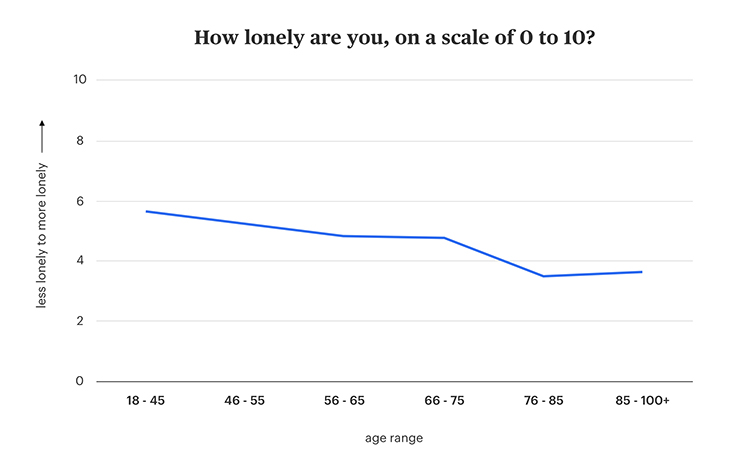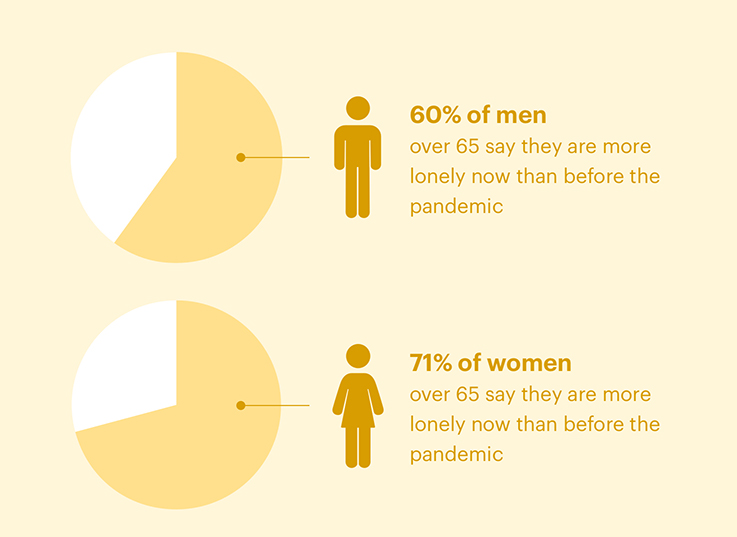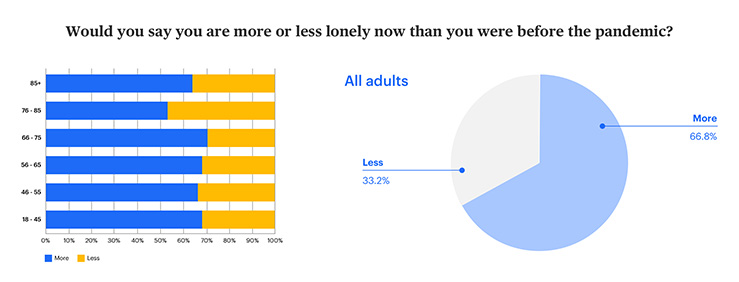Elderly Loneliness Statistics
Adults report feeling more isolated in 2021

The COVID-19 pandemic created shutdowns, stay-at-home orders and event hiatuses. Though few of us were unaffected by the impacts, it seems some demographics may have experienced higher levels of loneliness due to social isolation than others.
- 28% of seniors live alone, totaling more than 14.7 million people (5 million men and 9.7 million women).
- Loneliness and social isolation increase the risk of dementia by 50%. Other health risks related to loneliness include:
- Stroke: Risk increases by 32%
- Heart disease: Risk increases by 29%
- Mental health disorders: Risk increases by 26%
- Premature mortality: Risk increases by 26%
- The health effects of loneliness are equivalent to smoking 15 cigarettes each day.
2021 Consumer Wellness Survey: Loneliness
According to our recent survey of nearly 1,000 people, most adults are more lonely now than they were prior to the coronavirus pandemic. People between the ages of 66 and 75 most frequently said they are more lonely now than they were previously.
However, younger people (under 55) were more likely to rate their loneliness on a higher scale. Those aged 76 to 85 were the least likely to feel more lonely now than before the pandemic.

- About the survey
- The ConsumerAffairs research team surveyed 988 people between May 13 and May 21, 2021. We asked respondents to rate their current level of loneliness on a scale from zero to 10, with 10 being the most lonely. Respondents also self-reported whether they felt “more” or “less” lonely than they did before the pandemic and why, as well as their age, gender and location.
Why are adults so lonely in 2021?
People across all age groups said they felt isolated because they couldn’t see their friends and family or meet new people. Anecdotally, our analysis suggests that different age groups emphasized various reasons for their loneliness.
- Ages 46 to 55 are likely to mention divorce.
- Ages 18 to 55 and 76 to 85 are equally likely to mention the government (about half as frequently as adults aged 56 to 75).
- Ages 56 to 65 are likely to mention deaths of friends, family members or pets.
- Ages 66 to 75 are likely to mention limited shopping opportunities.
Before the pandemic I felt lonely. During the pandemic there was a reason or an excuse to be lonely. Now that a lot of restrictions are lifted there's no more excuse to feel lonely. It’s made me realize how alone I really am.”
– Senior survey respondent in Oklahoma (female)
Before the pandemic, 1 in 4 people older than 65 experienced social isolation, putting them at greater risk of loneliness, according to the U.S. Centers for Disease Control. The exact number of seniors who feel lonely is difficult to pinpoint, but one study surveyed adults over 60 and found 43% of respondents felt lonely.
These feelings of loneliness were exacerbated by the COVID-19 pandemic. A University of Michigan poll found 56% of adults 50 to 80 reported feelings of isolation in June 2020. Though the survey included respondents below the senior age range, it demonstrated a stark contrast to reported feelings of loneliness in 2018, when 27% of respondents reported feelings of isolation.

Risk factors
Loneliness can affect anyone and is often a response to a range of personal events and factors. Sudden changes (including loss of a spouse or loved one), changes in mobility, lack of transportation and separation from friends and family, can promote feelings of loneliness.
- Family: Spouses and children
- Some seniors may feel lonely because they’re unmarried, divorced or widowed. Of course, married seniors aren’t immune to loneliness — sometimes feelings of isolation are due to growing apart or other marital issues. It can also occur when one spouse has to take a caregiving role for their partner because of disease or injury.
In the mid-1980s, when baby boomers were of childbearing age, the birth rate began to decline, suggesting boomers were having fewer children than their parents. This trend will likely continue with future generations, leading the birth rate to plummet.
Childlessness doesn’t necessarily mean seniors are at a higher risk of loneliness, as research is still limited in this field. Oftentimes, elderly individuals who don’t have kids find other support systems, but children typically provide more long-term and financial support to parents.
While nearly one-third of individuals over 65 live alone, researchers emphasize the difference between physical isolation and feelings of loneliness. A 2012 study from UCSF suggested that living alone is not a prerequisite to loneliness. At the time, 43% of surveyed adults 60 and over reported feelings of loneliness, though only 18% lived alone.
- Neighborhood: Crime rates, walkability and public transit
- For many, loneliness is exacerbated by factors outside of an individual’s control. In 2019, Dr. Elena Portacolone studied elder isolation in high-crime neighborhoods. She found that while the individuals aged 58 to 90 she interviewed longed to participate in society socially, they faced obstacles that limited their participation.
Portacolone’s research concluded that neighborhoods should be made safer and more accessible for older residents. For high-crime neighborhoods, the study recommended improved sidewalks, better lighting, renovating decaying buildings, security, home care aides, social workers and affordable transportation to make social participation more accessible for seniors in these neighborhoods.
Beyond the context of this study, a growing percentage of seniors say they value walkability in their neighborhoods. A study from A Place for Mom found 53% of those in apartments, 38% of those in independent living situations and 26% of assisted living residents prefer walkable communities.
According to the U.S. Bureau of Transportation Statistics, people over 65 make an average of 3.4 trips per day. As of 2018, there are over 45 million licensed drivers over 65 — but as seniors are more likely to give up driving as they get older and deal with chronic illness and eyesight loss. Over 3.5 million adults over 85 have a driver’s license, which forms a percentage significantly lower than for the general senior population.
A study and literature review from the National Center for Mobility Management and the University of Minnesota found public transportation has a role in responding to loneliness and social isolation. The research also noted that accessibility, knowledge of how to use transit, affordability and flexibility of service impact how older adults use public transit.
Though limited in scope, community transportation programs can offer curbside pickup and drop-off to seniors in need. Accessible transportation not only facilitates getting to medical appointments and the grocery store but also offers rides to activities seniors may not otherwise be able to attend.
- Loss: Loved ones and hobbies
- One in five Americans know someone who died due to COVID-19. For adults over 65, who accounted for 80% of all COVID-19 deaths, this number is likely higher. Many seniors in long-term care facilities also witnessed widespread infection. According to the COVID Tracking Project, deaths in long-term care residencies contributed to more than one-third of all COVID-19 deaths.
The sheer scale of the pandemic and its impact on elder Americans has left seniors significantly affected by personal loss of friends and family and more vulnerable to loneliness.
The loss of a hobby can also prompt loneliness. Enjoyable tasks like knitting may become more difficult with the onset of arthritis, and even reading is more difficult as eyesight becomes less sharp. As seniors age, the hobbies that previously helped prevent loneliness may no longer be accessible.
- Changes: Communication and technology
- Whether or not they experienced direct loss from the pandemic, lockdowns over the past year to prevent the spread of COVID-19 made seniors more vulnerable to social isolation. People hoping to prevent the spread to at-risk family members weren’t able to visit parents, grandparents and other elderly loved ones. Nursing homes and other long-term care facilities stopped allowing visitors altogether.
Some seniors experimented with new digital technology to stay in touch. The digital platform Senior Planet created Zoom classes and social events for people over 65. Classes like meditation and Tai Chi even saw more digital participants than they had in person prior to the pandemic.
Still, many seniors aren’t fully engaged with digital technology. About 27% of people over 65 aren’t online at all, and certain tech trends aren’t accessible to all seniors. Small phone screens can be hard to read even with customized settings, and tightening skin and muscle strains can make touch screens difficult to navigate.
Pew Research surveys found 61% of adults over 65 own a smartphone, while an additional 29% own a mobile phone that’s not a smartphone. A 2019 study found that seniors who used video chat platforms like Skype had lower risks of developing depression than those who communicated via social media, email or text messaging.
While some people assume senior resistance to technology is caused by a lack of knowledge about how to use certain platforms, it might also have to do with new tech being made without the older population in mind.
Health consequences
The health effects of loneliness are nearly equivalent to smoking 15 cigarettes a day. Loneliness has even been estimated to shorten a person’s life span by as much as 15 years.
Unlike mental health disorders such as depression, loneliness often isn’t diagnosed. However, it still can promote negative cognitive and physical health effects. Chronic loneliness can affect how people trust others — and, for lonely individuals, trying to engage socially can lead to feelings of burnout that make loneliness cyclical.
Loneliness may also increase the risks of serious health conditions such as dementia (by 50%), stroke (by 32%) heart disease (by 29%), mental health disorders (by 26%) and premature mortality (by 26%), according to the Health Resources and Services Administration.
The mental health effects of loneliness may include sleep problems, anxiety and other issues. University of California San Francisco’s research also found that lonely seniors were 59% more likely to find daily tasks such as climbing stairs or walking more difficult.
- Mental health effects
- Depression
- Anxiety
- Increased stress
- Sleep problems
- Low self-esteem
- Physical health effects
- Dementia
- Stroke
- Heart disease
- Premature mortality
- Weakened immune system
Fighting loneliness
Urban planners and architects are considering how to build communities and neighborhoods that meet the needs of an aging population and promote connections across generations. For example, architect Matthias Hollwich has pioneered “New Aging” architecture in hopes of creating communities with walkable access to grocery stores, pharmacies and shopping. He also imagines the future of senior living to be more connected with the communities they’re in, especially for residents without nearby families.
“What we can do is come up with a new idea of family, and design spaces that allow for neighbors to have the same kind of emotional responses as family members,” Hollwich told Curbed. “Half of nursing home residents are there because of social deficits and the loss of their social net, not because of health issues; we need to find ways to help them connect."

Loneliness can be hard to treat among seniors because it isn’t often talked about. But if the underlying cause is found and addressed, lonely feelings can be reversed.
Platforms like Zoom have shown diversity in use over the past year. As vaccination rates rise and in-person events become more common, there may still be a place for webcam-based events and workshops that let seniors engage socially while avoiding obstacles that make outside socialization and transportation difficult.
For immediate mental health or substance abuse services, contact the U.S. Substance Abuse and Mental Health Services Administration's (SAMHSA) national hotline at 1-800-662-HELP (4357).
Bottom line
The pandemic has highlighted the crisis of loneliness across generations, but for seniors, who were especially limited in terms of social interaction, 2020 allowed for a rethinking of how they communicate with each other and cross-generationally. The lessons of the pandemic could help leaders in senior living better address loneliness among people over 65.
- Article sources
- ConsumerAffairs writers primarily rely on government data, industry experts and original research from other reputable publications to inform their work. Specific sources for this article include:
- Health Resources & Services Administration, “The Loneliness Epidemic.” Accessed June 4, 2021.
- The Administration for Community Living (ACL), “2019 Profile of Older Americans.” Accessed June 2, 2021.
- Michigan Institute for Healthcare Policy & Innovation, “Loneliness doubled among older adults in the first months of COVID-19, poll shows.” Accessed June 11, 2021.
- Centers for Disease Control (CDC), “Loneliness and Social Isolation Linked to Serious Health Conditions.” Accessed June 2, 2021.
- University of California San Francisco (UCSF), “Loneliness Linked to Serious Health Problems and Death Among Elderly.” Accessed June 2, 2021.
- University Institute for Healthcare Policy & Innovation, “Loneliness doubled among older adults in the first months of COVID-19, poll shows.” Accessed June 2, 2021.
- U.S. Census Bureau, “Multigenerational Households.” Accessed June 2, 2021.
- National Institute on Aging,”Social isolation, loneliness in older people pose health risks.” Accessed June 2, 2021.
- Scientific American, “Loneliness is Harmful to our Nation’s Health.” Accessed June 11, 2021.
- Oxford Academic, “‘I Feel Trapped’: The Tension Between Personal and Structural Factors of Social Isolation and the Desire for Social Integration Among Older Residents of a High-Crime Neighborhood.” Accessed June 11, 2021.
- U.S. Department of Transportation, “Bureau of Transportation Statistics.” Accessed June 11, 2021.
- National Center for Mobility Management, “The Role of Transportation in Addressing Social Isolation in Older Adults.” Accessed June 11, 2021.
- University of Chicago, “Nearly one-fifth of Americans know someone who has died of COVID-19, survey says.” Accessed June 11, 2021.
- Pew Research Center, “Internet/Broadband Fact Sheet.” Accessed June 11, 2021.
- The American Journal of Geriatric Psychiatry, “Using Skype to Beat the Blues: Longitudinal Data from a National Representative Sample.” Accessed June 11, 2021.
You’re signed up
We’ll start sending you the news you need delivered straight to you. We value your privacy. Unsubscribe easily.